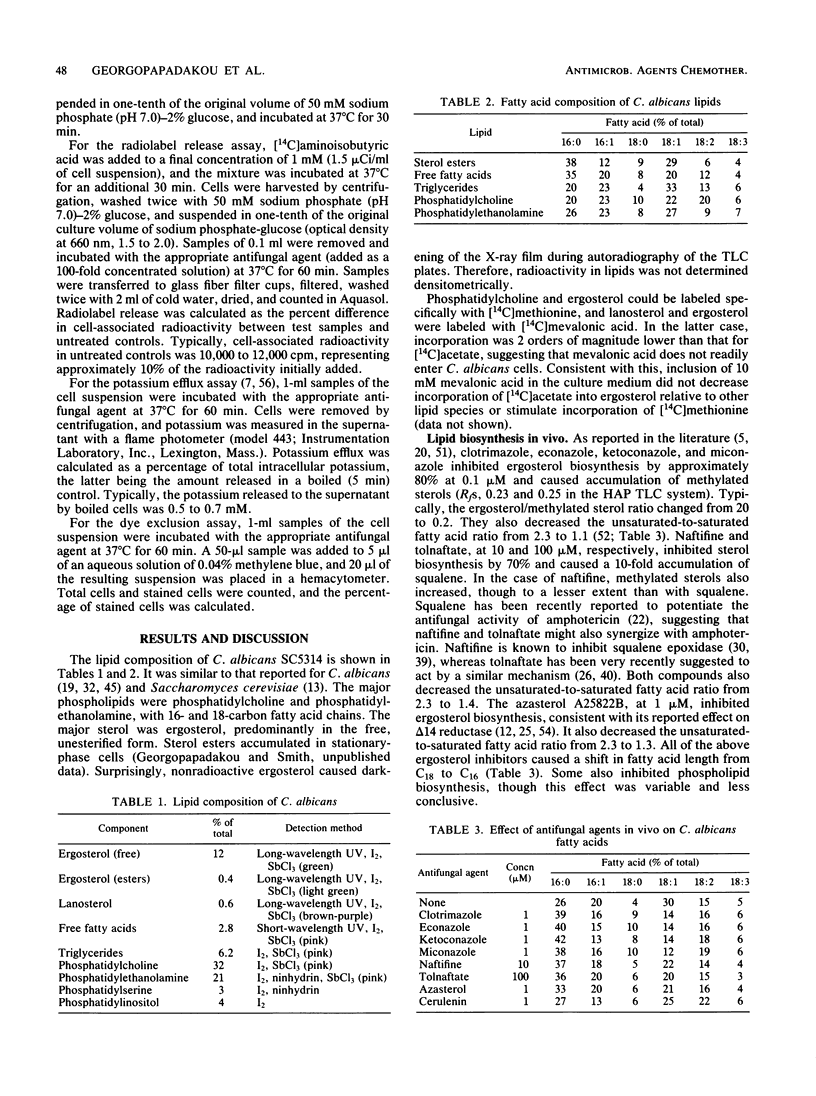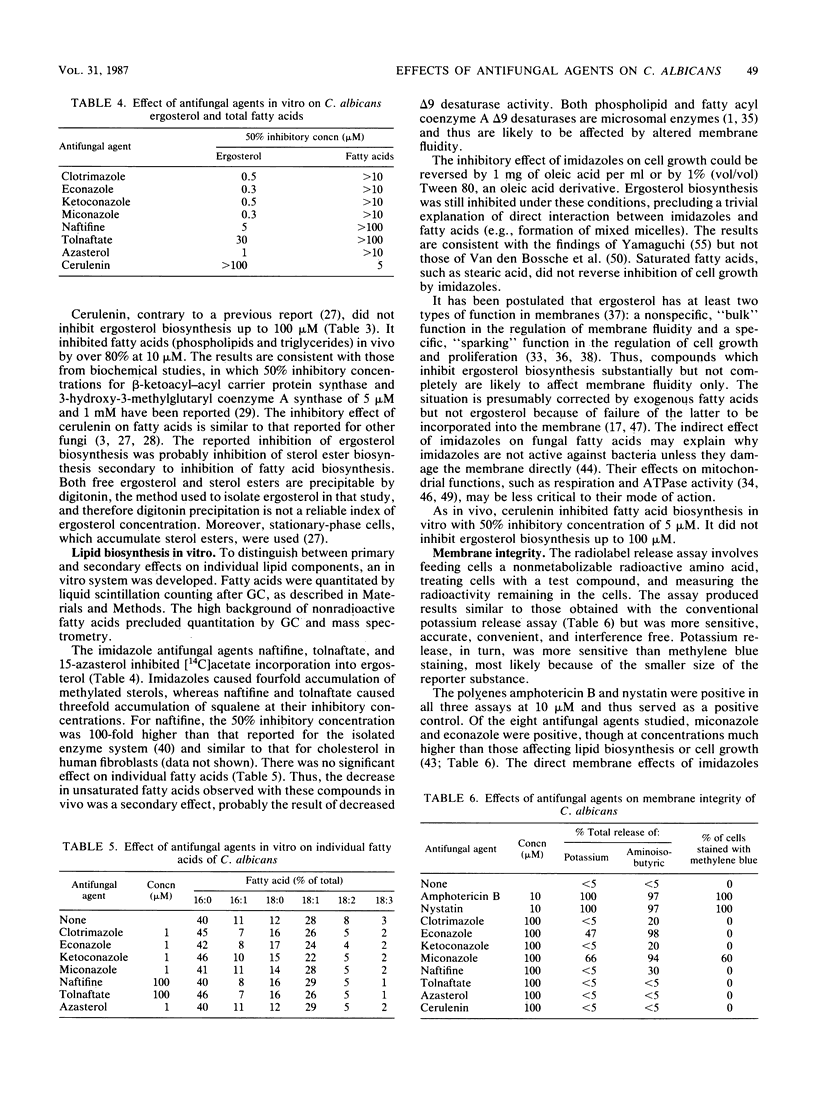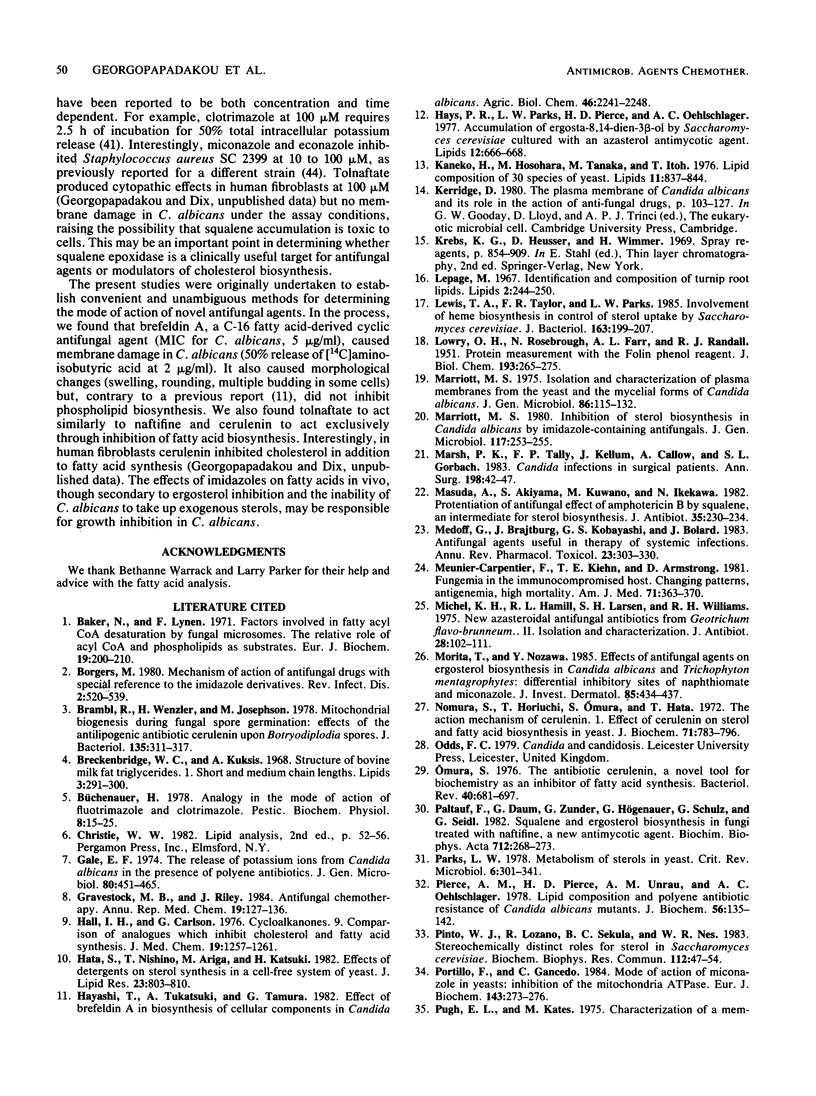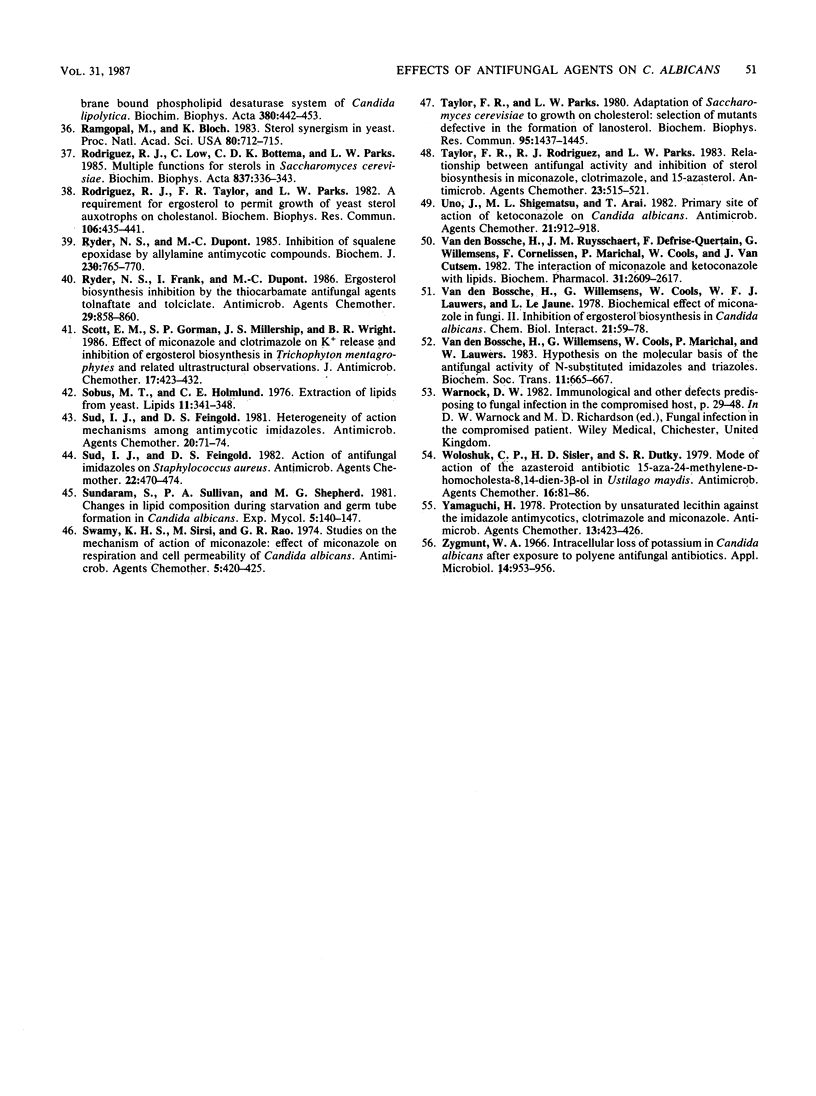Abstract
Eight antifungal agents were examined for effects on lipid biosynthesis and membrane integrity in Candida albicans. Lipids were labeled in vivo or in vitro with [14C]acetate and analyzed by thin-layer and gas chromatography. Membrane integrity was measured by a recently developed [14C]aminoisobutyric acid radiolabel release assay. The imidazole antifungal agents miconazole, econazole, clotrimazole, and ketoconazole, at concentrations inhibiting ergosterol biosynthesis (0.1 microM), decreased the ratio of unsaturated to saturated fatty acids in vivo but not in vitro. Similarly, naftifine, tolnaftate, and the azasterol A25822B, at concentrations inhibiting ergosterol biosynthesis (10, 100, and 1 microM, respectively), decreased the ratio of unsaturated to saturated fatty acids in vivo only. This suggests that the effect on fatty acids observed with ergosterol biosynthesis inhibitors may be secondary to the effect on ergosterol. With imidazoles, oleic acid antagonized inhibition of cell growth but not inhibition of ergosterol. This suggests that, with the C-14 demethylase inhibitors, decreased unsaturated fatty acids, rather than decreased ergosterol, are responsible for growth inhibition. Cerulenin, previously reported to be a potent inhibitor of both fatty acid and ergosterol biosynthesis, was found in the present study to inhibit the former (at 5 microM) but not the latter (up to 100 microM). Of the antifungal agents tested, econazole and miconazole (at 100 microM) produced complete release of [14C]aminoisobutyric acid, which is consistent with membrane damage.
Full text
PDF





Selected References
These references are in PubMed. This may not be the complete list of references from this article.
- Baker N., Lynen F. Factors involved in fatty acyl CoA desaturation by fungal microsomes. The relative roles of acyl CoA and phospholipids as substrates. Eur J Biochem. 1971 Mar 11;19(2):200–210. doi: 10.1111/j.1432-1033.1971.tb01305.x. [DOI] [PubMed] [Google Scholar]
- Borgers M. Mechanism of action of antifungal drugs, with special reference to the imidazole derivatives. Rev Infect Dis. 1980 Jul-Aug;2(4):520–534. doi: 10.1093/clinids/2.4.520. [DOI] [PubMed] [Google Scholar]
- Brambl R., Wenzler H., Josephson M. Mitochondrial biogenesis during fungal spore germination: effects of the antilipogenic antibiotic cerulenin upon Botryodiplodia spores. J Bacteriol. 1978 Aug;135(2):311–317. doi: 10.1128/jb.135.2.311-317.1978. [DOI] [PMC free article] [PubMed] [Google Scholar]
- Breckenridge W. C., Kuksis A. Structure of bovine milk fat triglycerides : I. Short and medium chain lengths. Lipids. 1968 Jul;3(4):291–300. doi: 10.1007/BF02530927. [DOI] [PubMed] [Google Scholar]
- Gale E. F. The release of potassium ions from Candida albicans in the presence of polyene antibiotics. J Gen Microbiol. 1974 Feb;80(2):451–465. doi: 10.1099/00221287-80-2-451. [DOI] [PubMed] [Google Scholar]
- Hall I. H., Carlson G. L. Cycloalkanones. 9. Comparison of analogues which inhibit cholesterol and fatty acid synthesis. J Med Chem. 1976 Oct;19(10):1257–1261. doi: 10.1021/jm00232a019. [DOI] [PubMed] [Google Scholar]
- Hata S., Nishino T., Ariga N., Katsuki H. Effect of detergents on sterol synthesis in a cell-free system of yeast. J Lipid Res. 1982 Aug;23(6):803–810. [PubMed] [Google Scholar]
- Hays P. R., Parks L. W., Pierce H. D., Jr, Oehlschlager A. C. Accumulation of ergosta-8,14-dien-3beta-ol by Saccharomyces cerevisiae cultured with an azasterol antimycotic agent. Lipids. 1977 Aug;12(8):666–668. doi: 10.1007/BF02533762. [DOI] [PubMed] [Google Scholar]
- Kaneko H., Hosohara M., Tanaka M., Itoh T. Lipid composition of 30 species of yeast. Lipids. 1976 Dec;11(12):837–844. doi: 10.1007/BF02532989. [DOI] [PubMed] [Google Scholar]
- LOWRY O. H., ROSEBROUGH N. J., FARR A. L., RANDALL R. J. Protein measurement with the Folin phenol reagent. J Biol Chem. 1951 Nov;193(1):265–275. [PubMed] [Google Scholar]
- Lepage M. Identification and composition of turnip root lipids. Lipids. 1967 May;2(3):244–250. doi: 10.1007/BF02532563. [DOI] [PubMed] [Google Scholar]
- Lewis T. A., Taylor F. R., Parks L. W. Involvement of heme biosynthesis in control of sterol uptake by Saccharomyces cerevisiae. J Bacteriol. 1985 Jul;163(1):199–207. doi: 10.1128/jb.163.1.199-207.1985. [DOI] [PMC free article] [PubMed] [Google Scholar]
- Marriott M. S. Inhibition of sterol biosynthesis in Candida albicans by imidazole-containing antifungals. J Gen Microbiol. 1980 Mar;117(1):253–255. doi: 10.1099/00221287-117-1-253. [DOI] [PubMed] [Google Scholar]
- Marriott M. S. Isolation and chemical characterization of plasma membranes from the yeast and mycelial forms of Candida albicans. J Gen Microbiol. 1975 Jan;86(1):115–132. doi: 10.1099/00221287-86-1-115. [DOI] [PubMed] [Google Scholar]
- Marsh P. K., Tally F. P., Kellum J., Callow A., Gorbach S. L. Candida infections in surgical patients. Ann Surg. 1983 Jul;198(1):42–47. doi: 10.1097/00000658-198307000-00008. [DOI] [PMC free article] [PubMed] [Google Scholar]
- Masuda A., Akiyama S., Kuwano M., Ikekawa N. Potentiation of antifungal effect of amphotericin B by squalene, an intermediate for sterol biosynthesis. J Antibiot (Tokyo) 1982 Feb;35(2):230–234. doi: 10.7164/antibiotics.35.230. [DOI] [PubMed] [Google Scholar]
- Medoff G., Brajtburg J., Kobayashi G. S., Bolard J. Antifungal agents useful in therapy of systemic fungal infections. Annu Rev Pharmacol Toxicol. 1983;23:303–330. doi: 10.1146/annurev.pa.23.040183.001511. [DOI] [PubMed] [Google Scholar]
- Meunier-Carpentier F., Kiehn T. E., Armstrong D. Fungemia in the immunocompromised host. Changing patterns, antigenemia, high mortality. Am J Med. 1981 Sep;71(3):363–370. doi: 10.1016/0002-9343(81)90162-5. [DOI] [PubMed] [Google Scholar]
- Michel K. H., Hamill R. L., Larsen S. H., Williams R. H. New azasteroidal antifungal antibiotics from Geotrichum flavo-brunneum. II. Isolation and characterization. J Antibiot (Tokyo) 1975 Feb;28(2):102–111. doi: 10.7164/antibiotics.28.102. [DOI] [PubMed] [Google Scholar]
- Morita T., Nozawa Y. Effects of antifungal agents on ergosterol biosynthesis in Candida albicans and Trichophyton mentagrophytes: differential inhibitory sites of naphthiomate and miconazole. J Invest Dermatol. 1985 Nov;85(5):434–437. doi: 10.1111/1523-1747.ep12277141. [DOI] [PubMed] [Google Scholar]
- Nomura S., Horiuchi T., Omura S., Hata T. The action mechanism of cerulenin. I. Effect of cerulenin on sterol and fatty acid biosynthesis in yeast. J Biochem. 1972 May;71(5):783–796. doi: 10.1093/oxfordjournals.jbchem.a129827. [DOI] [PubMed] [Google Scholar]
- Omura S. The antibiotic cerulenin, a novel tool for biochemistry as an inhibitor of fatty acid synthesis. Bacteriol Rev. 1976 Sep;40(3):681–697. doi: 10.1128/br.40.3.681-697.1976. [DOI] [PMC free article] [PubMed] [Google Scholar]
- Parks L. W. Metabolism of sterols in yeast. CRC Crit Rev Microbiol. 1978;6(4):301–341. doi: 10.3109/10408417809090625. [DOI] [PubMed] [Google Scholar]
- Pierce A. M., Pierce H. D., Jr, Unrau A. M., Oehlschlager A. C. Lipid composition and polyene antibiotic resistance of Candida albicans mutants. Can J Biochem. 1978 Feb;56(2):135–142. doi: 10.1139/o78-023. [DOI] [PubMed] [Google Scholar]
- Pinto W. J., Lozano R., Sekula B. C., Nes W. R. Stereochemically distinct roles for sterol in Saccharomyces cerevisiae. Biochem Biophys Res Commun. 1983 Apr 15;112(1):47–54. doi: 10.1016/0006-291x(83)91795-3. [DOI] [PubMed] [Google Scholar]
- Portillo F., Gancedo C. Mode of action of miconazole on yeasts: inhibition of the mitochondrial ATPase. Eur J Biochem. 1984 Sep 3;143(2):273–276. doi: 10.1111/j.1432-1033.1984.tb08369.x. [DOI] [PubMed] [Google Scholar]
- Pugh E. L., Kates M. Characterization of a membrane-bound phospholipid desaturase system of candida lipolytica. Biochim Biophys Acta. 1975 Mar 24;380(3):442–453. doi: 10.1016/0005-2760(75)90112-5. [DOI] [PubMed] [Google Scholar]
- Ramgopal M., Bloch K. Sterol synergism in yeast. Proc Natl Acad Sci U S A. 1983 Feb;80(3):712–715. doi: 10.1073/pnas.80.3.712. [DOI] [PMC free article] [PubMed] [Google Scholar]
- Rodriguez R. J., Low C., Bottema C. D., Parks L. W. Multiple functions for sterols in Saccharomyces cerevisiae. Biochim Biophys Acta. 1985 Dec 4;837(3):336–343. doi: 10.1016/0005-2760(85)90057-8. [DOI] [PubMed] [Google Scholar]
- Rodriguez R. J., Taylor F. R., Parks L. W. A requirement for ergosterol to permit growth of yeast sterol auxotrophs on cholestanol. Biochem Biophys Res Commun. 1982 May 31;106(2):435–441. doi: 10.1016/0006-291x(82)91129-9. [DOI] [PubMed] [Google Scholar]
- Ryder N. S., Dupont M. C. Inhibition of squalene epoxidase by allylamine antimycotic compounds. A comparative study of the fungal and mammalian enzymes. Biochem J. 1985 Sep 15;230(3):765–770. doi: 10.1042/bj2300765. [DOI] [PMC free article] [PubMed] [Google Scholar]
- Ryder N. S., Frank I., Dupont M. C. Ergosterol biosynthesis inhibition by the thiocarbamate antifungal agents tolnaftate and tolciclate. Antimicrob Agents Chemother. 1986 May;29(5):858–860. doi: 10.1128/aac.29.5.858. [DOI] [PMC free article] [PubMed] [Google Scholar]
- Scott E. M., Gorman S. P., Millership J. S., Wright L. R. Effect of miconazole and clotrimazole on K+ release and inhibition of ergosterol biosynthesis in Trichophyton mentagrophytes and related ultrastructural observations. J Antimicrob Chemother. 1986 Apr;17(4):423–432. doi: 10.1093/jac/17.4.423. [DOI] [PubMed] [Google Scholar]
- Sobus M. T., Homlund C. E. Extraction of lipids from yeast. Lipids. 1976 Apr;11(4):341–348. doi: 10.1007/BF02544064. [DOI] [PubMed] [Google Scholar]
- Sreedhara Swamy K. H., Sirsi M., Ramananda Rao G. R. Studies on the mechanism of action of miconazole: effect of miconazole on respiration and cell permeability of Candida albicans. Antimicrob Agents Chemother. 1974 Apr;5(4):420–425. doi: 10.1128/aac.5.4.420. [DOI] [PMC free article] [PubMed] [Google Scholar]
- Sud I. J., Feingold D. S. Action of antifungal imidazoles on Staphylococcus aureus. Antimicrob Agents Chemother. 1982 Sep;22(3):470–474. doi: 10.1128/aac.22.3.470. [DOI] [PMC free article] [PubMed] [Google Scholar]
- Sud I. J., Feingold D. S. Heterogeneity of action of mechanisms among antimycotic imidazoles. Antimicrob Agents Chemother. 1981 Jul;20(1):71–74. doi: 10.1128/aac.20.1.71. [DOI] [PMC free article] [PubMed] [Google Scholar]
- Taylor F. R., Parks L. W. Adaptation of Saccharomyces cerevisiae to growth on cholesterol: selection of mutants defective in the formation of lanosterol. Biochem Biophys Res Commun. 1980 Aug 29;95(4):1437–1445. doi: 10.1016/s0006-291x(80)80058-1. [DOI] [PubMed] [Google Scholar]
- Taylor F. R., Rodriguez R. J., Parks L. W. Relationship between antifungal activity and inhibition of sterol biosynthesis in miconazole, clotrimazole, and 15-azasterol. Antimicrob Agents Chemother. 1983 Apr;23(4):515–521. doi: 10.1128/aac.23.4.515. [DOI] [PMC free article] [PubMed] [Google Scholar]
- Uno J., Shigematsu M. L., Arai T. Primary site of action of ketoconazole on Candida albicans. Antimicrob Agents Chemother. 1982 Jun;21(6):912–918. doi: 10.1128/aac.21.6.912. [DOI] [PMC free article] [PubMed] [Google Scholar]
- Van den Bossche H., Ruysschaert J. M., Defrise-Quertain F., Willemsens G., Cornelissen F., Marichal P., Cools W., Van Cutsem J. The interaction of miconazole and ketoconazole with lipids. Biochem Pharmacol. 1982 Aug 15;31(16):2609–2617. doi: 10.1016/0006-2952(82)90707-9. [DOI] [PubMed] [Google Scholar]
- Van den Bossche H., Willemsens G., Cools W., Marichal P., Lauwers W. Hypothesis on the molecular basis of the antifungal activity of N-substituted imidazoles and triazoles. Biochem Soc Trans. 1983 Dec;11(6):665–667. doi: 10.1042/bst0110665. [DOI] [PubMed] [Google Scholar]
- Woloshuk C. P., Sisler H. D., Dutky S. R. Mode of action of the azasteroid antibiotic 15-aza-24 methylene-d-homocholesta-8,14-dien-3 beta-ol in Ustilago maydis. Antimicrob Agents Chemother. 1979 Jul;16(1):81–97. doi: 10.1128/aac.16.1.81. [DOI] [PMC free article] [PubMed] [Google Scholar]
- Yamaguchi H. Protection by unsaturated lecithin against the imidazole antimycotics, clotrimazole and miconazole. Antimicrob Agents Chemother. 1978 Mar;13(3):423–426. doi: 10.1128/aac.13.3.423. [DOI] [PMC free article] [PubMed] [Google Scholar]
- Zygmunt W. A. Intracellular Loss of Potassium in Candida albicans After Exposure to Polyene Antifungal Antibiotics. Appl Microbiol. 1966 Nov;14(6):953–956. doi: 10.1128/am.14.6.953-956.1966. [DOI] [PMC free article] [PubMed] [Google Scholar]
- van den Bossche H., Willemsens G., Cools W., Lauwers W. F., Le Jeune L. Biochemical effects of miconazole on fungi. II. Inhibition of ergosterol biosynthesis in Candida albicans. Chem Biol Interact. 1978 Apr;21(1):59–78. doi: 10.1016/0009-2797(78)90068-6. [DOI] [PubMed] [Google Scholar]


